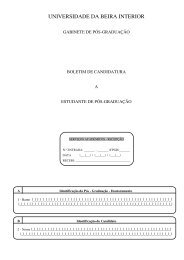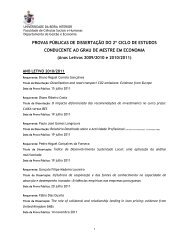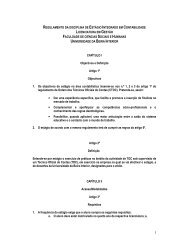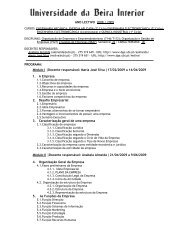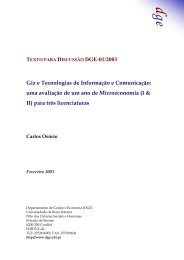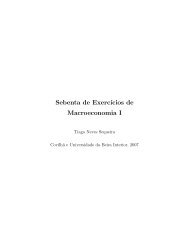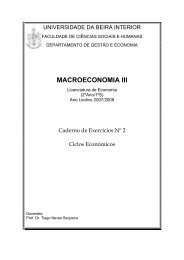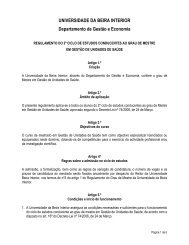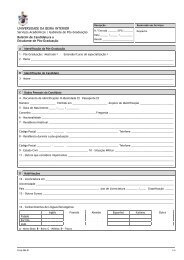Sebenta de Exercícios Resolvidos - O DGE - UBI
Sebenta de Exercícios Resolvidos - O DGE - UBI
Sebenta de Exercícios Resolvidos - O DGE - UBI
You also want an ePaper? Increase the reach of your titles
YUMPU automatically turns print PDFs into web optimized ePapers that Google loves.
42CAPÍTULO 5. MODELO IS-LM EM ECONOMIA FECHADA E PROCURA AGREGADA<br />
E por fim encontramos Y <strong>de</strong> equilíbrio resolvendo um sistema<br />
entre as duas equações, a da IS e a da LM:<br />
{ [ ]<br />
Y =<br />
1<br />
(1−c(a+fg)) C + I + G −<br />
b<br />
i<br />
(1−c(a+fg))<br />
Y = 1M/P + hi<br />
k k<br />
⇔<br />
⇔<br />
⇔<br />
{<br />
1<br />
k M/P + h k i = 1<br />
(1−c(a+fg))<br />
{ (<br />
h<br />
k +<br />
b<br />
(1−c(a+fg))<br />
⎧<br />
⎪⎨<br />
⇔<br />
⎪⎩ Y =<br />
[<br />
C + I + G<br />
]<br />
−<br />
b<br />
(1−c(a+fg)) i<br />
− − − − − − − − − − − − −−<br />
)<br />
1<br />
i =<br />
(1−c(a+fg))<br />
− − − − − − − − − − − − −−<br />
1<br />
(1−c(a+fg))[C+I+G]−<br />
i =<br />
1 k M/P<br />
( h k + b<br />
(1−c(a+fg)))<br />
h/k<br />
(1−c(a+fg))[C+I+G]− h/k<br />
k M/P<br />
( h k + b<br />
(1−c(a+fg)))<br />
[<br />
C + I + G<br />
]<br />
−<br />
1<br />
k M/P<br />
+ 1 k M/P<br />
⇔<br />
⇔<br />
c) Para encontrar os valores do rendimento e da taxa <strong>de</strong> juro<br />
basta substituir os parametros pelos respectivos valores usando<br />
para isso o quadro construido na resposta a alínea a)<br />
Y =<br />
i =<br />
1<br />
(1−0.8(0.6+0.4×1.08)) [100+30+5]− 1<br />
20 ×2500<br />
( 0.5<br />
20 + 350<br />
(1−0.8(0.6+0.4×1.08)))<br />
0.5/20<br />
(1−0.8(0.6+0.4×1.08))<br />
( 0.5<br />
20 + 350<br />
[100+30+5]−<br />
0.5/20<br />
20 ×2500<br />
(1−0.8(0.6+0.4×1.08)))<br />
+ 1 20<br />
= 0.323<br />
× 50 = 125.01<br />
d) Se os preços se alterassem 20%, para que os resultados da<br />
alínea anterior não se alterassem, a oferta nominal <strong>de</strong> moeda teria<br />
que alterar-se na mesma percentagem. Se os preços se alterarem<br />
e a moeda nominal se mantiver constante M/P 1 = 2500/1.2. =<br />
2083. 3 Então, os valores <strong>de</strong> equilíbrio serão:<br />
Y =<br />
i =<br />
0.5/20<br />
(1−0.8(0.6+0.4×1.08))<br />
1<br />
(1−0.8(0.6+0.4×1.08)) [100+30+5]− 1<br />
20 ×2083.3<br />
( 0.5<br />
20 + 350<br />
(1−0.8(0.6+0.4×1.08)))<br />
0.5/20<br />
[100+30+5]− ×2083.3<br />
20<br />
(1−0.8(0.6+0.4×1.08)))<br />
( 0.5<br />
20 + 350<br />
= 0.33381<br />
+ 1 × 2083.333 = 104.18<br />
20<br />
Tal como se po<strong>de</strong> verificar pelo gráfico seguinte a taxa <strong>de</strong> juro<br />
nominal aumenta e o rendimento diminui, tal como aconteceria<br />
numa recessão monetária.<br />
Gráfico:



